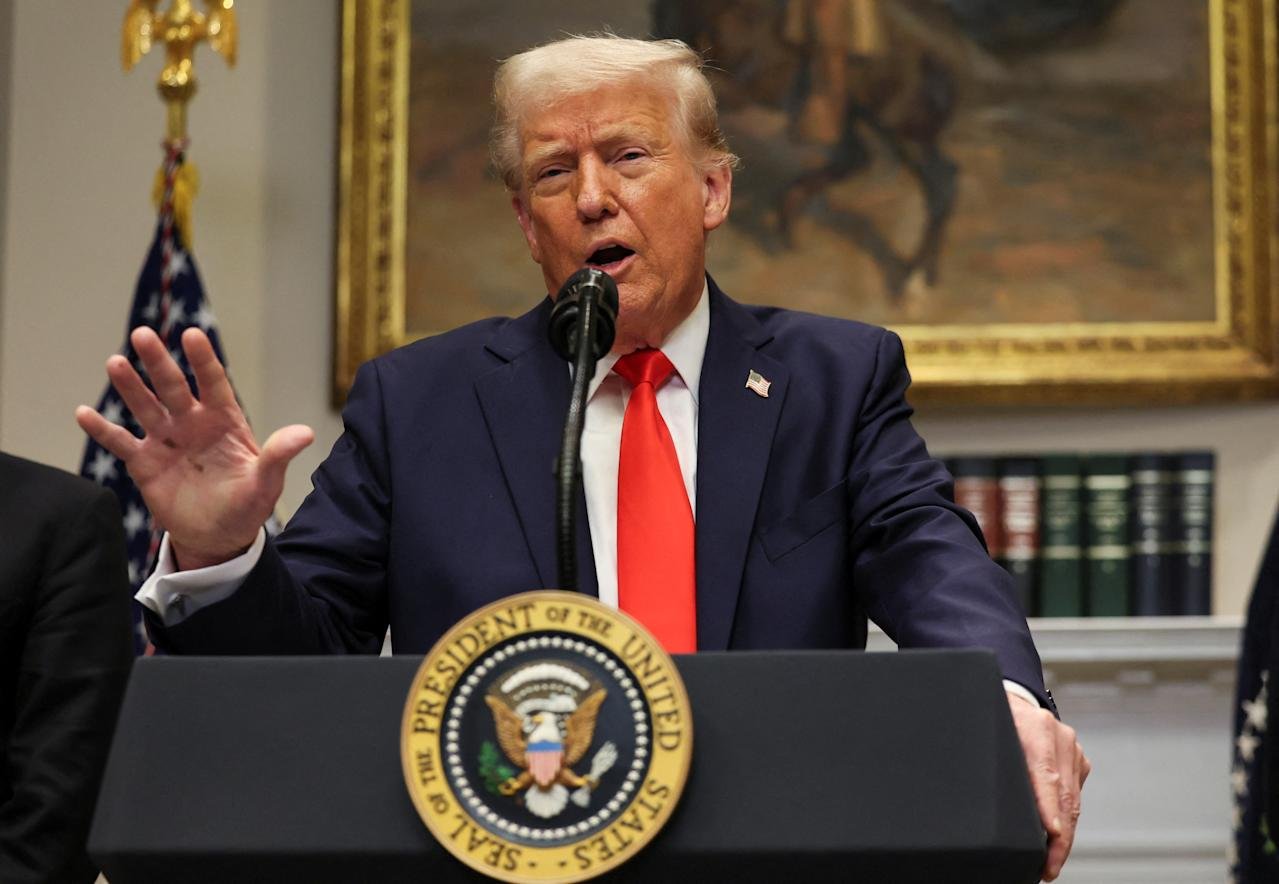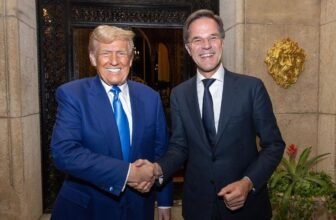
Donald Trump is not backing down from his trade war policies, despite considering potential tweaks to tariffs on Canada and Mexico. As he continues to champion his “America First” economic agenda, Trump’s strategic recalculations could reshape North American trade relations and have ripple effects through global markets. His protectionist trade agenda is not adjusting to changing realities of international trade and increasing economic pressures.
Trump’s Trade War Strategy Is Back — and Better Than Ever
The Donald Trump administration initiated one of the biggest overhauls of U.S. trade policy in memory. He started a global trade war in 2018 to correct perceived trade imbalances and reduce the U.S. trade deficit, particularly with China. By levying aggressive tariffs, Trump sought to return American jobs to the states, grow domestic manufacturing, and counter what he saw as predatory trade practices from foreign powers.
Although Trump left office in 2021, his trade policies have continued to resonate in U.S. economic circles. As the 2024 presidential election looms, Trump reasserts his protectionist messaging, stressing the vital role of tariffs in the global marketplace. The former president has not budged, convinced as he has long been that the remedy to securing better trade deals for the United States is through more tariffs.
And while much of the focus has been on his trade war with China, Trump’s relationships with Canada and Mexico, two of the United States’ most important trade partners, are still affecting American society and economy. The tariffs that were levied on these countries during his presidency upended cross-border trade flows, disrupting industries like agriculture, manufacturing, and energy. Now, however, Trump is considering changing these tariffs again; questions arise about the tension of trade between Canada, Mexico, and the United States.
Trump’s Legacy of a Trade War: Key Dates and Lasting Effects
U.S.-China Trade War: The View from 30,000 Feet
The U.S.-China trade war was the centerpiece of Trump’s international trade agenda. From 2018 to 2020, Trump enacted tariffs on more than $370 billion in Chinese goods, including consumer goods, steel, aluminum, and electronics. These tariffs, aimed at reducing China’s trade practices, included its theft of intellectual property and market access issues. China responded with its own tariffs on American agricultural exports, causing significant disruptions to American farmers.
The trade war, which caused pain to some U.S. industries, also yielded trade agreements like the Phase One Trade Deal with China that tackled intellectual property and aimed to promote more imports of U.S. goods into China. Nevertheless, the trade war’s long-term effects, especially on American consumers, were mixed — with many goods becoming more expensive because of tariffs.
Trump Reshapes North American Trade: The USMCA and NAFTA
Among Trump’s most significant achievements was renegotiating the North American Free Trade Agreement (NAFTA), which he argued had benefited Mexico and Canada at the expense of American workers. But the U.S. signed — in 2018 — the United States-Mexico-Canada Agreement (USMCA), which replaced NAFTA. Other updates were aimed at addressing specific concerns Trump had raised regarding AMTA, including what he claimed were shortcomings in the automotive sector, workers’ rights, and intellectual property protections.
But the adoption of steel and aluminum tariffs on Canada and Mexico during Trump’s presidency soured relations between the United States and its two closest neighbors. Nevertheless, throughout these tensions, the USMCA was intact, and trade between the three countries continued, albeit overshadowed by fears of nationalist policies affecting the relationship.
What It Means for U.S. Manufacturers and Farmers
Trump’s tariffs produced mixed effects across industries. On one side, they offered relief to U.S. manufacturers when foreign imports had been undercutting domestic production for American industries like steel and aluminum. Other industries dependent on cross-border supply chains, like the automotive industry, faced increased costs, and American consumers were hit with rising prices.
The agricultural sector was especially susceptible to retaliatory tariffs, with farmers seeing diminished exports in a vital market — China, as well as Canada and Mexico. In response, the U.S. government implemented trade aid packages to keep farmers afloat, but experts are still debating how the trade war will affect American agriculture in the long run.
Trump’s Tariff Situation with Canada and Mexico
Trump has praised tariffs as a means of protecting American industries, but he is now considering alterations to the tariffs on Canada and Mexico. That is a sign of a policy change that could signal a rounding of the corner on U.S. trade relations in North America. So the question is whether Trump will continue to give trade deals a dose of tariffication, or instead go with a little more collaboration.
Key Issues at Play
A few major factors here are likely guiding Trump’s possible tariff changes on Canada and Mexico:
- High Stampede for Cross-Border Trade in the Automotive Industry: Mexico and Canada are among the most important commercial partners of the U.S. automotive industry due to its dependence on parts and materials imported from those countries. Tariffs on automotive parts and finished vehicles can greatly raise costs for American manufacturers and could result in job losses and production delays.
- Agricultural Exports: The United States is an important agricultural exporter to Canada and Mexico. Tariffs in this sector have disrupted trade, and an update to the tariff structure could stabilize U.S. agricultural exports, especially for crops like corn, soybeans, and wheat.
- Energy Trade: Tariffs on energy products could affect the flow of energy resources, pushing up costs and creating energy shortages in the U.S. market.
- Political Calculus: Trade is also a question of politics for Trump. Trump’s protectionist rhetoric resonates with a big segment of his base, especially in areas that have been hammered by globalization, as he prepares for a likely 2024 run for president. But any changes to tariffs have to weigh economic reality against the political imperative of maintaining strong support among voters who support his “America First” agenda.
Would Tweaking Tariffs Alter Trade Relations Between the U.S., Canada, and Mexico?
Made up of the world’s two largest economies and one of the lowest-cost energy producers, U.S.-Canada-Mexico trilateral trade relations would be affected by any tariff changes. This might facilitate trade or cooperation between the nations if Trump chooses to retract or lower certain tariffs. On the other hand, any ill-advised hike in tariffs might elicit retaliatory moves, escalating tensions and damaging relationships that have taken decades to forge.
Is There a Stabilized Trade Environment?
If Trump acts to roll back tariffs with Canada and Mexico, he might be praised by industries that rely on cross-border supply chains, creating cost savings for U.S. manufacturers and consumers. Over the longer term, even more relief may be in store, especially for the auto and agricultural sectors, as trade restrictions fall and market access expands.
A Return to Protectionism?
On the other hand, if Trump chooses to pursue more aggressive tariff policies, this could lead to a period of economic uncertainty in North America. Retaliatory tariffs imposed by Canada and Mexico would increase costs for U.S. consumers, especially in sectors like agriculture and manufacturing. And it could damage U.S. relations, both with the countries directly affected by such retaliation, as well as with its neighbors, complicating negotiations of potential future trade deals.
Economic and Geopolitical Considerations
Trump’s tariff policy is not only a domestic issue, but a global one as well. A focus on protectionist policies does risk alienating other trading partners, specifically in Europe and Asia. Countries such as China, the European Union, and Japan are watching closely for signs of a similar turn in the U.S. toward more aggressive trade tactics.
The Global Trade Landscape
The larger question is whether tariffs and trade wars can work in a globalized economy, even if Trump’s policies have focused on bilateral trade deficits on the whole. As countries become more dependent on each other for goods and services, the dangers of waging chronic trade wars become clearer.
Tensions Between Nations and Trade Barriers
Geopolitical dynamics also could affect the future of U.S. trade policy under Trump. The U.S. may not only find itself isolated in its trade approach, as tensions escalate with China, but other nations may increasingly seek closer trade ties beyond the traditional order of allies and adversaries led by the U.S..
Conclusion: Trump’s Trade War — A Future Uncertain?
Donald Trump’s view on tariffs is a cornerstone of his economic philosophy. The limits of trade relationships will be vital as he weighs negotiating changes for tariffs on Canada and Mexico. It is still early to tell if these adjustments will lead to a more **co






